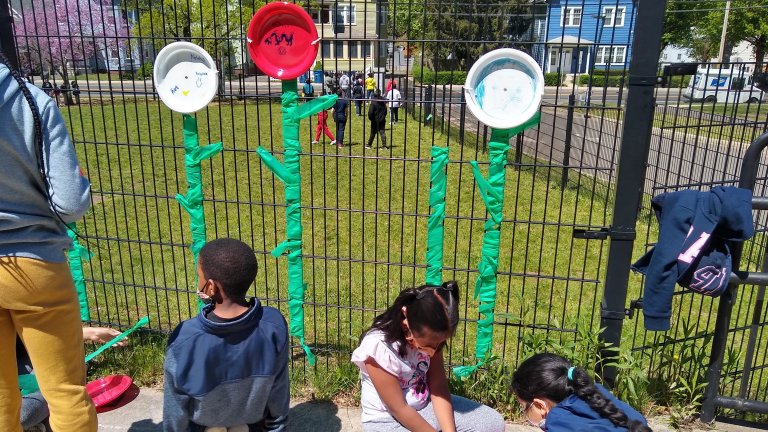
School Context: Bishop Woods is a K-8, Title 1 public magnet school located in New Haven, CT, with an architecture and design theme. Although traditionally a neighborhood school located outside the city center, the school transitioned to magnet status in 2016. The school was designated a Magnet Schools of America School of Excellence in 2020. Through partnerships with local organizations, Bishop Woods is able to enhance programming for students - through integrated units of study, additional programming that enhances the school magnet theme, wrap around social emotional services, and after school programming. Approximately one third of graduating students attend a New Haven magnet school, one third a neighborhood school, and one third a regional technical high school.
Curricular Context: K-8, All grade levels, interdisciplinary
Overarching Goal: By developing schoolwide projects to improve the Outdoor Learning Program at Bishop Woods:
- Students will become more connected to the spaces and develop ownership and stewardship of the school grounds
- School staff will build individual capacity and increase teaching and learning opportunities outdoors
- Families will build understanding of the outdoor program at Bishop Woods and will support school efforts
Projects:
- Underground Mural
- Music Wall
- K-8 Outdoor Day
As part of this overarching goal, the unit described here focuses on building stewardship of the school grounds through an Outdoor Day with various stations and activities.
Environment
Bishop Woods is a K-8 magnet school located in New Haven, CT, with an architecture and design theme. The school property has a large amount of outdoor space and backs onto a bird sanctuary. Its physical assets include its geology, existing garden and habitat space, being next door to a bird sanctuary, outdoor seating and tables, proximity to the Quinnipiac Salt Marsh,and rainwater. Social assets include a strong outdoor team, inter-grade student cohort groups, well-developed magnet-theme connections, the availability of woodworking tools, and a strong relationship with Common Ground, a community partner and supporter of outdoor learning at the school.
Challenges include recent vandalism, poor sunlight in some areas, steep hills, poor water quality, and lack of accountability for project completion.
Unused space on the school property was seen as both an asset and a challenge as we developed this project.
We hoped that this project would help students become more connected to the outdoor spaces at the school and develop ownership and stewardship of the school grounds through:
- Habitat maintenance
- Art installations
- Plantings
Additional Resources: Bishop Woods Mapping Tool
Expectations
Guiding Questions:
- What does it mean to be a positive member of our outdoor community?
- How can we use the outdoor space to enhance overall learning at Bishop Woods?
Standards:
CASEL SEL Framework
The CASEL 5 addresses five broad, interrelated areas of competence and examples for each:
- self-awareness
- Self-management
- social awareness
- relationship skills
- responsible decision-making
Science/NGSS
- Make observations
- Ask and answer questions.
- Compare and contrast key ideas.
Literacy
- CCSS.ELA-LITERACY.CCRA.SL.1 Prepare for and participate effectively in a range of conversations and collaborations with diverse partners, building on others' ideas and expressing their own clearly and persuasively.
Additional resources: NGSS, NGSS Standards PEs 5, NGSS by DCI, SS Guiding Principles, CT SS Framework, Nat’l C3 SS Framework, Common Core, ISTE Technology Standards for Students, Learning for Justice Social Justice Standards, CASEL SEL Framework
Exhibition
K-8 Outdoor Day:
- Culminating event - Schoolwide Outdoor Day
- Audience - All students Grades K- 8, All school staff
- Impact of student involvement - Students will:
- contribute to the beautification of the school grounds through regular habitat maintenance (weeding, mulching, pruning, raking) of different spaces (Kindness Rock Garden, Grassy Corner/Race Track location, Sunflower Patch)
- support installation of new plantings
- create Kindness Rocks
- participate in a Guided Hike SEL activity
- Seed Bomb creation (take home activity)
- Hike the Bishop Woods Sanctuary
- Fence weaving art installation
- 6A’s -
- Academic rigor - students apply higher order thinking and habits of mind
- Adult connections - work with teachers in staff in meaningful ways outdoors
- Authenticity - improvement of schoolyard
- Applied learning - teamwork
- Active exploration -
- Assessment - students completed Outdoor Day reflections
Experience
Step 1: Identify Outdoor Priorities for the 2020-2021 SY
Step 2: Identity team member leads on different projects
Step 3: Conduct PD on outdoor learning and use of spaces
Step 4: Analyze staff feedback to support design of Outdoor Day plan and schedules
Step 5: Plan for Outdoor Day
- Purchase materials
- Contract with Common Ground for partnership work
- Develop schedule
Step 6: Host Outdoor Day
Step 7: Conduct reflections through student surveys
Step 8: Identify student interest in “Junior Habitat”
Additional Resources:
Reflections
The Outdoor Day event at Bishop Woods was extremely successful. Every in-person student visited at least 5 stations and participated in projects related to maintenance of the habitat, art installations, outdoor learning experiences, and more. An after school event was held for virtual students to attend in order to experience parts of the outdoor events.
The event was developed to:
- Build community
- Conduct needed maintenance
- Make new students and teachers more comfortable with the outdoor spaces and how to use them
- Connect students to the outdoor space
Although the original goal was to increase stewardship of the school grounds and create more investment and engagement by students for the outdoor spaces, we are not confident the event itself developed that thinking. Deeper connections were not made prior to the event to scaffold understanding about the importance of stewardship. As this is a recurring event each year, we will create opportunities in advance of the event (and all outdoor learning initiatives) for students to better understand their place in the schoolyard.
